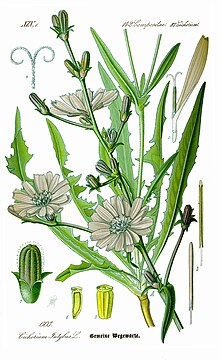Chicory
Common chicory (Cichorium intybus)[4] is a somewhat woody, perennial herbaceous plant of the dandelion family Asteraceae. It usually has bright blue flowers, rarely white or pink.[3]
| Common chicory | |
|---|---|

| |
| 1885 illustration[1] | |

| |
| Scientific classification | |
| Kingdom: | Plantae |
| Clade: | Tracheophytes |
| Clade: | Angiosperms |
| Clade: | Eudicots |
| Clade: | Asterids |
| Order: | Asterales |
| Family: | Asteraceae |
| Tribe: | Cichorieae |
| Genus: | Cichorium |
| Species: | C. intybus
|
| Binomial name | |
| Cichorium intybus | |
| Synonyms[2][3] | |
|
Synonymy
| |
It is often used as a food plant, and often as a coffee substitute. Many varieties are cultivated for salad leaves, chicons (blanched buds), or roots. The roots of variety sativum are baked, ground, and used as a coffee substitute and food additive.
In the 21st century, inulin, an extract from chicory root, has been used in food manufacturing as a sweetener and source of dietary fibre.[5]
Chicory is grown as a forage crop for livestock.[6] It lives as a wild plant on roadsides in its native Europe, and is now common in North America, China, and Australia, where it has become widely introduced.[7][8][9]
"Chicory" is also the common name in the United States for curly endive (Cichorium endivia). These two closely related species are often confused.[10]
References
change- ↑ illustration from Prof. Dr. Otto Wilhelm Thomé Flora von Deutschland, Österreich und der Schweiz 1885, Gera, Germany
- ↑ "Cichorium intybus L. synonyms". Tropicos.org. Missouri Botanical Garden. Retrieved 23 March 2014.
- ↑ 3.0 3.1 "Cichorium intybus L." The Plant List. 2013. Archived from the original on 16 December 2020. Retrieved 23 March 2014.
- ↑ "Cichorium intybus". FAO - Food and Agriculture Organization of the UN. Archived from the original on 2013-05-23. Retrieved 2013-12-16.
- ↑ Raninen K.; Lappi; et al. (2011). "Dietary fiber type reflects physiological functionality: comparison of grain fiber, inulin, and polydextrose". Nutrition Reviews. 69 (1): 9–21. doi:10.1111/j.1753-4887.2010.00358.x. PMID 21198631.
- ↑ Blair, Robert (2011-04-30). Nutrition and Feeding of Organic Cattle. ISBN 978-1-84593-758-4.
- ↑ "Cichorium intybus". Flora of North America. Archived from the original on 12 April 2023. Retrieved 23 March 2014.
- ↑ Flora of China, Cichorium intybus Linnaeus, 1753. 菊苣 ju ju Archived March 3, 2016, at the Wayback Machine
- ↑ Atlas of Living Australia Archived March 5, 2016, at the Wayback Machine
- ↑ "Endive, Chicory and Witloof". Aggie Horticulture. Texas AgriLife Extension Service, Texas A&M System. Retrieved 2013-12-16.